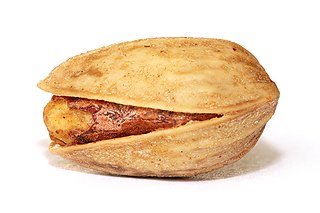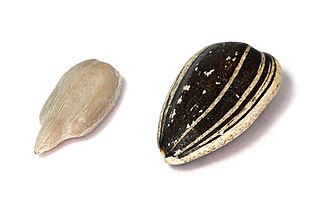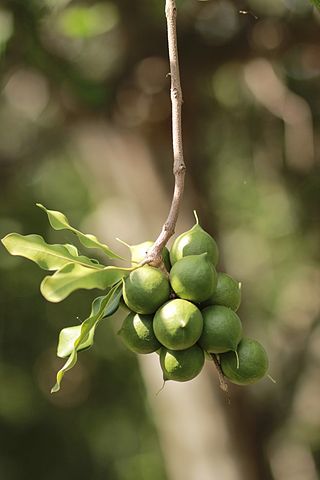
The almond is a species of tree from the genus Prunus. Along with the peach, it is classified in the subgenus Amygdalus, distinguished from the other subgenera by corrugations on the shell (endocarp) surrounding the seed.

The pistachio, a member of the cashew family, is a small to medium tree originating in Persia. The tree produces seeds that are widely consumed as food. The word can be countable or uncountable, meaning its plural is with or without an 's'.

A sunflower seed is a seed from a sunflower. There are three types of commonly used sunflower seeds: linoleic, high oleic, and sunflower oil seeds. Each variety has its own unique levels of monounsaturated, saturated, and polyunsaturated fats. The information in this article refers mainly to the linoleic variety.

Anacardium, the cashews, are a genus of flowering plants in the family Anacardiaceae, native to tropical regions of the Americas. The best known species is Anacardium occidentale, which is commercially cultivated for its cashew nuts and cashew apples.

An accessory fruit is a fruit that contains tissue derived from plant parts other than the ovary. In other words, the flesh of the fruit develops not from the floral ovary, but from some adjacent tissue exterior to the carpel. As a general rule, the accessory fruit is a combination of several floral organs, including the ovary. In contrast, true fruit forms exclusively from the ovary of the flower.

A nut is a fruit consisting of a hard or tough nutshell protecting a kernel which is usually edible. In general usage and in a culinary sense, many dry seeds are called nuts. In a botanical context, "nut" implies that the shell does not open to release the seed (indehiscent).

The hazelnut is the fruit of the hazel tree and therefore includes any of the nuts deriving from species of the genus Corylus, especially the nuts of the species Corylus avellana. They are also known as cobnuts or filberts according to species.

The Brazil nut is a South American tree in the family Lecythidaceae, and it is also the name of the tree's commercially harvested edible seeds. It is one of the largest and longest-lived trees in the Amazon rainforest. The fruit and its nutshell – containing the edible Brazil nut – are relatively large and weigh as much as 2 kg (4.4 lb) in total. As food, Brazil nuts are notable for diverse content of micronutrients, especially a high amount of selenium. The wood of the Brazil nut tree is prized for its quality in carpentry, flooring, and heavy construction.

Macadamia is a genus of four species of trees in the flowering plant family Proteaceae. They are indigenous to Australia, native to northeastern New South Wales and central and southeastern Queensland specifically. Two species of the genus are commercially important for their fruit, the macadamia nut. Global production in 2015 was 160,000 tonnes. Other names include Queensland nut, bush nut, maroochi nut, bauple nut and, in the US, they are also known as Hawaii nut. It was an important source of bushfood for the Aboriginal peoples.

Juglans nigra, the eastern American black walnut, is a species of deciduous tree in the walnut family, Juglandaceae, native to North America. It grows mostly in riparian zones, from southern Ontario, west to southeast South Dakota, south to Georgia, northern Florida and southwest to central Texas. Wild trees in the upper Ottawa Valley may be an isolated native population or may have derived from planted trees.

Juglans regia, the Persian walnut, English walnut, Carpathian walnut, Madeira walnut, or, especially in Great Britain, common walnut, is an Old World walnut tree species native to the region stretching from the Caucasus eastward to the Kashmir region. It is widely cultivated across Eurasia and Northern America.

Syzygium malaccense is a species of flowering tree native to tropical Asia and Australia. It is one of the species cultivated since prehistoric times by the Austronesian peoples. They were carried and introduced deliberately to Remote Oceania as canoe plants. In modern times, it has been introduced throughout the tropics, including many Caribbean countries and territories.

Anacardium excelsum, the wild cashew or espavé, is a tree in the flowering plant family Anacardiaceae. The tree is common in the tropical and subtropical dry broadleaf forests of Pacific and Atlantic watersheds of Central and South America, extending as far north as Guatemala and south into Ecuador.

Semecarpus anacardium, commonly known as the marking nut tree, Malacca bean tree, marany nut, oriental cashew, dhobi nut tree and varnish tree, is a native of India, found in the outer Himalayas to the Coromandel Coast. It is closely related to the cashew.

Anacardic acids are phenolic lipids, chemical compounds found in the shell of the cashew nut. An acid form of urushiol, they also cause an allergic skin rash on contact, known as urushiol-induced contact dermatitis. Anacardic acid is a yellow liquid. It is partially miscible with ethanol and ether, but nearly immiscible with water. Chemically, anacardic acid is a mixture of several closely related organic compounds. Each consists of a salicylic acid substituted with an alkyl chain that has 15 or 17 carbon atoms. The alkyl group may be saturated or unsaturated; anacardic acid is a mixture of saturated and unsaturated molecules. The exact mixture depends on the species of the plant. The 15-carbon unsaturated side chain compound found in the cashew plant is lethal to Gram-positive bacteria.

Cardanol is a phenolic lipid obtained from anacardic acid, the main component of cashew nutshell liquid (CNSL), a byproduct of cashew nut processing. Cardanol finds use in the chemical industry in resins, coatings, frictional materials, and surfactants used as pigment dispersants for water-based inks. It is used to make phenalkamines, which are used as curing agents for the durable epoxy coatings used on concrete floors. The name of the substance is derived by contraction from the genus Anacardium, which includes the cashew tree, Anacardium occidentale. The name of the genus itself is based on the Greek word for heart.

Sanoor is a village in the southern state of Karnataka, India. During the British Raj, the village was headed by the Patels (Patler). Since independence, it has been administered by a mandala Panchayati raj. The nearest court is in Karkala, 5 kilometres (3.1 mi) from the village center. Sanoor has several primary schools and a government pre-university college. The Tulu language is widely spoken; other languages spoken in the village are Konkani and Kannada. The Bunt and Billava were early ethnic communities, with the Marathi, Konkani and Brahmins arriving later. With Portuguese settlement, villagers converted to Catholicism. Local Muslims belong to the Moplah community, are known as Beary and speak the Beary dialect of Tulu. The Beary, living in the region for over a thousand years, may be descended from Arab traders.
Anacardium othonianum is a tree native from the tropical savanna (cerrado) region of Brazil, whose fruit is similar to that of the common cashew tree of the Brazilian Northeast. It is locally known by the Tupi-derived name cajuí, and by the Portuguese names caju-de-árvore-do-cerrado, caju-vermelho-de-goiás, cajuzinho-do-cerrado or just cajuzinho.

The Cashew business in Kollam is based in the eponymous city, which is known as the Cashew Capital of the World. Kollam is the largest processed cashew exporter in the world. As of 2011 there were more than 600 cashew processing units in the city. About 800,000 tonnes of raw cashews are imported to the city for processing every year. 80% of India's export quality cashew kernels were prepared in Kollam. Kollam has remained the cashew capital of the world since the 1930s.
































